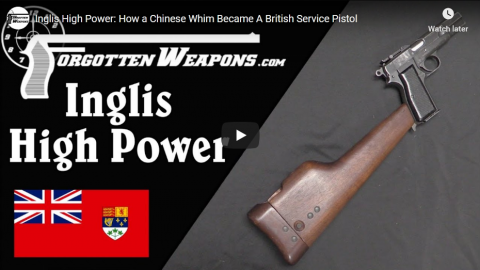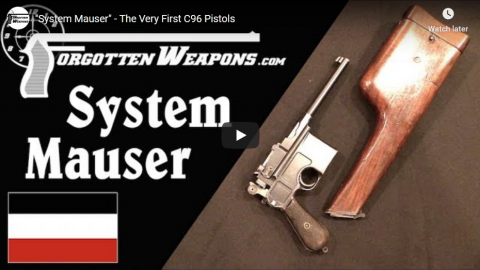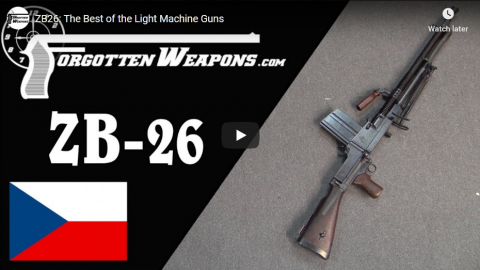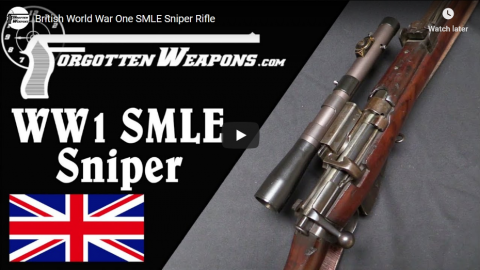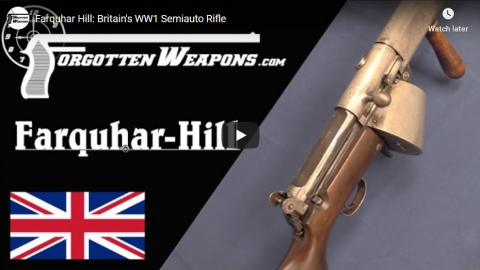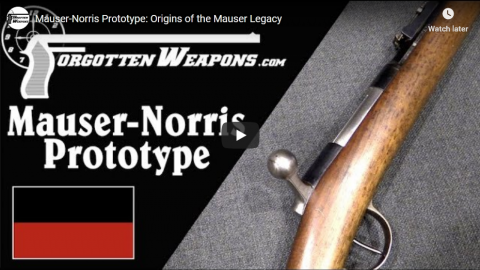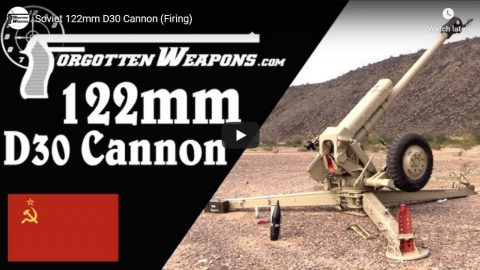Forgotten Weapons
Published 25 Jan 2018Sold for $3,163.
During World War Two, the Canadian government set up a loan program to help Chinese companies provide all manner of material aid to Canada’s allies. Among many others, one recipient of this aid was the Nationalist Chinese government under Chiang Kai Shek. Chinese representatives asked the John Inglis company to manufacture no less than 180,000 Browning High Power pistols, and the company agreed.
After some wrangling, Inglis acquired a license from FN representatives to make the guns, got a complete technical package through the British government and FN’s representatives in exile, and the direct personal aid of Laloux and Saive from FN. Delivery proved difficult, though, with only about 4000 guns being shipped to Karachi and then needing to be flown over The Hump in cargo planes, along with massive amounts of other aid — and a few pistols didn’t get a lot of priority there.
By the fall of 1944, the contract was cancelled under concerns that it was not really contributing to any progress in the war against the Japanese, along with insistence from American General Stilwell that the Chinese forces be armed with weapons that could be supplied more easily through the American logistic network. Production restarted after the defeat of Germany, with another 40,000 or so being made and delivered before it was cancelled again when the Nationalist Chinese forces were seen to be clearly losing to their Communist opponents.
Each of these pistols was supplied with a combination shoulder stock and holster. In the US, attaching a stock to a pistol would normally subject it to registration as a Short Barreled Rifle, but the Inglis High Powers are among the guns exempted from this requirement. They are, in fact, among the least expensive and most modern guns to be exempted in this way.
http://www.patreon.com/ForgottenWeapons
Cool Forgotten Weapons merch! http://shop.bbtv.com/collections/forg…
If you enjoy Forgotten Weapons, check out its sister channel, InRangeTV! http://www.youtube.com/InRangeTVShow
June 3, 2020
Inglis High Power: How a Chinese Whim Became A British Service Pistol
May 30, 2020
Some of Ian’s Gun Collection, on a Matrix Armory Display Wall
Forgotten Weapons
Published 12 Apr 2017Matrix Armory is a new gun display system developed by Jeff High (a long-time Forgotten Weapons supporter, incidentally) who wanted something that would really do justice to guns that you want to display and appreciate. The other sorts of display/racking systems out there are much more industrial in style, primarily to store guns. Matrix Armory was designed to make your guns look their best, because nothing is quite as sad as a great gun collection squashed into a safe and never actually seen (assuming one has a secure room for display, naturally).
I have gotten a lot of people asking to see my own personal collection, and so I figured this would be a cool way to do that; showing you some of the highlights of my collection in conjunction with the Matrix Armory wall we installed in my office. I have no financial stake in the product — I think the years of work Jeff has put into it have led to a really nice product that I think will be of interest to some of the folks who read Forgotten Weapons.
May 27, 2020
Webley 1913 Semiauto Pistol: History and Disassembly
Forgotten Weapons
Published 25 May 2017William Whiting and the Webley company had high hopes for their self-loading pistols being adopted by the British military — but they never got the success they were hoping for.
After the poor performance of the Webley 1904 (https://www.youtube.com/watch?v=-hT38…) at trials, William Whiting decided to make sure his next attempt would be fully developed before he put it in the hands of the military. He did very well at that too, as the gun which would become the Model 1913 Webley did very well from its very first military tests. The Royal Navy was, in fact, quite enthusiastic about it, although the Army was not. The Navy would ultimately adopt the gun and purchase about 8,000 of them during World War One, while the Army acquired just a couple hundred and preferred to stick to its revolvers.
Thanks to Mike Carrick of Arms Heritage magazine for loaning me these pistols to bring to you!
Cool Forgotten Weapons merchandise! http://shop.bbtv.com/collections/forg...
http://www.patreon.com/ForgottenWeapons
If you enjoy Forgotten Weapons, check out its sister channel, InRangeTV! http://www.youtube.com/InRangeTVShow
May 23, 2020
“System Mauser” – The Very First C96 Pistols
Forgotten Weapons
Published 12 Feb 2020http://www.patreon.com/ForgottenWeapons
https://www.floatplane.com/channel/Fo…
Cool Forgotten Weapons merch! http://shop.bbtv.com/collections/forg…
The very first group of C96 pistols made — about 200 in total — are called “System Mauser” pistols. They have this hand-engraved on the top of the barrel, and have a number of other very early features that would quickly change. Most of these changes involve lightening the gun, but they also have a distinctive stepped barrel and a holster/stock that opened to the left; the opposite of all the later standard holsters.
Contact:
Forgotten Weapons
6281 N. Oracle #36270
Tucson, AZ 85740
May 20, 2020
ZB26: The Best of the Light Machine Guns
Forgotten Weapons
Published 26 Oct 2017Sold for $34,500 (transferrable).
The ZB-26 stands as one of the best magazine-fed light machine guns developed during the 1920s and 30s – it was a very popular gun for small military forces and many countries which did not directly buy it were strongly influenced by it. The Japanese Nambu Type 96 and 99 were heavily based on the ZB, and the British Bren was a direct evolution licensed from Brno.
The design dates back to 1921, when the Czech government began searching for a modern light machine gun. They tested pretty much all the guns available on the market at the time, and also solicited guns from Czechoslovak designers. Brothers Vaclav and Emmanuel Holek submitted their I-23 light machine gun, which would become the ZB-26 (LK vizor 26 in Czech terminology) and become the official Czechoslovak light machine gun as well as a popular commercial export for the ZB factory. More than 120,000 were made in several different calibers and sold to 24 countries between 1926 and 1939.
When the Germans occupied Czechoslovakia, they seized a huge number of these guns both from the military and guns still in the factory. This particular one was part of a Spanish purchase contract, but was completed under the oversight of Heinrich Krieghoff and supplied to German forces.
Mechanically, the ZB-26 uses a tilting bolt and a long stroke gas piston, in a combination that would be copied in many later designs. It is robust, accurate, controllable, and handy – a truly excellent all-around light machine gun.
http://www.patreon.com/ForgottenWeapons
Cool Forgotten Weapons merch! http://shop.bbtv.com/collections/forg…
If you enjoy Forgotten Weapons, check out its sister channel, InRangeTV! http://www.youtube.com/InRangeTVShow
May 17, 2020
British World War One SMLE Sniper Rifle
Forgotten Weapons
Published 17 Nov 2018https://www.forgottenweapons.com/brit…
http://www.patreon.com/ForgottenWeapons
Cool Forgotten Weapons merch! http://shop.bbtv.com/collections/forg…
The British started World War One without a sniper program, but were quick to develop one once faced with the threat of well-trained German snipers. The initial equipment used by the British was a motley collection of commercial hunting rifles, but by 1915 the government was issuing contract to mount mostly 3x and 4x telescopes on SMLE and Pattern 1914 rifles. About 10,000 scoped sniper rifles were issued in total during the war using a variety of scopes and mount types (a standardized pattern would not be adopted until 1918). The example we have here today is the most common type; an SMLE with an offset Periscopic Prism Company scope using a 5-screw mount assembled by the same company. Later in the war the offset mounts would slowly fall out of favor to the center-mounted scopes, which allowed better shooting at the cost of being able to use stripper clips.
Contact:
Forgotten Weapons
PO Box 87647
Tucson, AZ 85754
May 14, 2020
Farquhar Hill: Britain’s WW1 Semiauto Rifle
Forgotten Weapons
Published 20 Feb 2017The Farquhar-Hill was a semiauto rifle developed in Britain prior to World War 1. It was the idea of Birmingham gunsmith Arthur Hill, and financed by Aberdeen industrialist Mowbray Farquhar. The design began as a long-recoil system, but that was replaced with a unique spring-buffered gas operated mechanism before production began.
Basically, a gas port in the barrel taps gas off to a piston, which moved about 3 inches rearward and was then caught and held by a latch. At that point, the other end of the spring would be released to move backward, pushing on the bolt and bolt carrier, unlocking and cycling the action. This gave the rifle a very light felt recoil impulse, and also buffered the bolt from potential over-pressure cartridges.
The Farquhar-Hill was chambered for the .303 British cartridge, and in its military form fed from 19-round drum magazines. A large order for 100,000 rifles was placed by the British military, but cancelled when WW1 ended. A small number of the rifles were sold in the military pattern as well as in box magazine-fed sporting patterns, but Farquhar was more interested in pursuing military contracts, and would continue to work with machine gun designs going into the 1920s.
Thanks to the Institute of Military Technology for giving me access to these two rifles: http://www.instmiltech.com
http://www.patreon.com/ForgottenWeaponsCool Forgotten Weapons merch! http://shop.bbtv.com/collections/forg…
If you enjoy Forgotten Weapons, check out its sister channel, InRangeTV! http://www.youtube.com/InRangeTVShow
May 11, 2020
Imperial Gewehr 71
Forgotten Weapons
Published 30 Jan 2016Sold for $575.
The Gewehr 1871 was the first rifle adopted by the newly-formed German state after its unification at the end of the Franco-Prussian War. It replaced the decades-old Dreyse needle rifles, and fired an 11x60mm black powder cartridge. It was the first significant rifle designed by the Mauser brothers, and would evolve into the iconic and ubiquitous Mauser 98 design over the years.
May 8, 2020
Weapons as Political Protest: P.A. Luty’s Submachine Gun
Forgotten Weapons
Published 2 Aug 2017Armament Research Services (ARES) is a specialist technical intelligence consultancy, offering expertise and analysis to a range of government and non-government entities in the arms and munitions field. For detailed photos of the guns in this video, don’t miss the ARES companion blog post:
http://armamentresearch.com/pa-luty-9…
Phillip A. Luty was a Briton who took a hard philosophical line against gun control legislation in the UK in the 1990s. In response to more restrictive gun control laws, he set out to prove that all such laws were ultimately futile by showing that one could manufacture a functional firearm from hardware store goods, without using any purpose-made firearms parts.
Luty succeeded in this task, designing a 9mm submachine gun made completely from scratch with a minimum of tools. In 1998, he published the plans for his gun as the book Expedient Homemade Firearms. Luty was not particularly discreet about his activities (actually, he was quite outspoken…) and was eventually caught by the police while out to test fire one of his guns, and arrested. He was convicted, and spent several years in prison. He continued to pursue a gun rights agenda after being released, and was facing legal trouble again when he passed away from cancer in 2011.
Several of Luty’s submachine guns are still held in the collection of the Royal Armouries’ National Firearms Centre, including the one that led to his original conviction. Many thanks to the NFC for allowing me to bring that weapon to you!
http://www.patreon.com/ForgottenWeapons
Cool Forgotten Weapons merch! http://shop.bbtv.com/collections/forg…
If you enjoy Forgotten Weapons, check out its sister channel, InRangeTV! http://www.youtube.com/InRangeTVShow
May 5, 2020
Early Lever-Action Rifles: Volcanic, Henry, Winchester
Forgotten Weapons
Published 6 Feb 2016Hammer prices:
Volcanic – $19,550
1860 Henry – $15,960
1866 Winchester – $8,625We’ve all seen lever action rifles galore in movies about the old west, and most of us have handled and shot a bunch of them as well. But do you know where they came from?
Today we will take a look at the first American lever-action rifle put into successful (more or less) production, the Volcanic. We will then continue to examine the 1860 Henry and the 1866 Winchester to get a foundational understanding of the development of these guns, and the interesting group of people involved with them.
April 30, 2020
Browning M1917: America’s World War One Heavy Machine Gun
Forgotten Weapons
Published 14 Mar 2018When the United States entered World War One, its military has a relatively tiny handful of machine guns, and they were divided between four different types, as the military budget was small and machine guns were not given much priority. However, since the failure of his gas-operated 1895 machine gun design to become a popular military item, John Browning had been working on a recoil-operated machine gun to replace it. This work became serious in 1910, and by 1915 Browning had met with Colt and agreed to give them exclusive license to his new design — and they began to work with him to refine and perfect it.
When the United States realized that it would be fighting in Europe and would need machine guns in 1917, it held an open trial for designs which Colt and Browning entered. The Browning gun was the undisputed star of the show, firing 40,000 rounds with only one parts breakage and no malfunctions that were not the fault of ammunition or belts. The gun was almost immediately adopted and pushed into production. Ultimately, Colt would allow the manufacture of its guns by Remington and New England Westinghouse, and Browning himself would accept a lump-sum royalty payment from the government for its use, which was about 3.5 million dollars less than he was contractually entitled to — out of patriotism and a desire not to profit too much from the war.
Browning 1917 machine guns would see only brief combat use in World War One, first tasting action in September of 1918. They would remain a staple of US military armament through World War Two, however, improved after the Armistice to the M1917A1 pattern. The gun we are looking at today is an original WW1 M1917, mounted on an equally rare M1917 original tripod.
http://www.patreon.com/ForgottenWeapons
Cool Forgotten Weapons merch! http://shop.bbtv.com/collections/forg…
If you enjoy Forgotten Weapons, check out its sister channel, InRangeTV! http://www.youtube.com/InRangeTVShow
April 24, 2020
Mauser-Norris Prototype: Origins of the Mauser Legacy
Forgotten Weapons
Published 10 Jan 2020http://www.patreon.com/ForgottenWeapons
https://www.floatplane.com/channel/Fo…
Cool Forgotten Weapons merch! http://shop.bbtv.com/collections/forg…
Today we are looking at one of the rarest and earliest rifles built by Paul and Wilhelm Mauser, a design which would set in motion all the events that led to the Mauser company becoming one of the great world leaders in small arms. The Mauser brothers were born in Oberndorf am Necker in the Kingdom of Württemberg, sons of a gunsmith. They would take up their father’s trade and were creative and intelligent boys, but opportunities were limited in the small, rural town of Oberndorf. In 1865 they presented a rifle to the Austrian Army in Vienna for trials, where it was rejected. However, it was noticed by an American sales rep for the Remington Company, a man named Samuel Norris. Norris saw the potential in the Mauser brothers’ design to convert needlefire rifles to metallic cartridges, and he signed a deal with the brothers to further develop the system.
The Mausers moved to Liege Belgium to do their work, and within just a few years they were making rifles for Norris. This example is based on a Chassepot, as Norris hoped to sell the conversion system to the French Army. That deal was rejected, however (the French were happy sticking with paper cartridges as of 1868), and Norris’ plans began to unravel when the Remington company discovered that he was making dealings in his own name instead of for them. The Mauser brothers ended up walking away from the deal with ownership of the patents they had filed with Norris, and when they submitted the design to the Prussians a process began which would result in the Mauser Model 1871 being adopted. From there, their talents would lead to the whole line of Mauser repeating rifles culminating in the Model 1898, arguably the pinnacle of the bolt action military rifle.
Thanks to the Liege Arms Museum for access to film this for you! If you are in Belgium, definitely plan to stop into the museum, part of the Grand Curtius. They have a very good selection of interesting and unusual arms on display. Further thanks to the Paul Mauser Archive for helping to arrange this filming!
http://www.paul-mauser-archive.com
Contact:
Forgotten Weapons
6281 N. Oracle #36270
Tucson, AZ 85740
April 22, 2020
The REAL Heroes of the M1 Carbine – not “Carbine” Williams
Forgotten Weapons
Published 21 Apr 2020http://www.patreon.com/ForgottenWeapons
https://www.floatplane.com/channel/Fo…
Cool Forgotten Weapons merch! http://shop.bbtv.com/collections/forg…
The Hollywood-spawned mythos of the M1 Carbine is that it was created by David Marshall “Carbine” Williams. The reality is far different. In real life, Williams was talented, but short-tempered, stubborn, and unable to work effectively as part of a team — and a cohesive, cooperative team is what the M1 Carbine required.
While Williams was off sulking about how the work was being done wrong, a team of Winchester machinists and engineers including William Roemer and Fred Humiston were actually making it happen.
The most impressive anecdote of the whole story, to me, is from when the solitary Winchester prototype broke its bolt in the middle of the final testing. Fred Humiston was representing Winchester at the trials, and he was told that if he could provide a new bolt within 24 hours the gun could continue the trials — but he could not take the gun off the testing ground. So Humiston went back to the Winchester shop and made a new bolt from memory (no drawings yet existed for the gun) and without being able to test-fit it in the gun. When he returned the next day, his new bolt dropped in perfectly, and the gun went on to win the trials. That is an epic feat of skill, and it is really a shame that he does not get more recognition for it.
Contact:
Forgotten Weapons
6281 N. Oracle #36270
Tucson, AZ 85740
April 21, 2020
Soviet 122mm D30 Cannon (Firing)
Forgotten Weapons
Published 4 Jan 2020http://www.patreon.com/ForgottenWeapons
Cool Forgotten Weapons merch! http://shop.bbtv.com/collections/forg…
The D30 is a Soviet 122mm multi-role gun introduced in the 1960s and still in use around the world today. It has a somewhat unusual 3-leg mount that is slower to set up than a standard trail, but allows for complete 360-degree rotation of the gun. The piece was designed for both indirect fire (maximum range 15.4km; more with rocket-assisted munitions) or direct anti-tank fire. Note that it came with an armor shield for the crew, which was left off the gun for this trip to the range.
Thanks to Battlefield Vegas for the chance to film this awesome cannon firing! It belongs to them, and will be set up at their facility for a pretty awesome rental firing experience if you are into that…
http://www.battlefieldvegas.com
Contact:
Forgotten Weapons
6281 N. Oracle #36270
Tucson, AZ 85704
April 17, 2020
Prototype Mauser 1917 Trench Carbine
Forgotten Weapons
Published 20 Dec 2019http://www.patreon.com/ForgottenWeapons
Cool Forgotten Weapons merch! http://shop.bbtv.com/collections/forg…
In the latter stages of World War One, the German military was looking for new arms for its Sturmtruppen. Without a reliable self-loading rifle design to use, they instead focused on pistol-caliber arms. The first to be used was the existing P08 artillery Luger, fitted with a drum magazine. At the very end of the war, these were being replaced by Bergmann MP-18,I submachine guns. But there was another gun that was tested but not adopted — the 1917 trench carbine variation of Mauser’s C96 “Broomhandle” pistol. Only about 40 of these guns were made as prototypes and trials models, and they were not adopted for reasons that are not entirely clear (but cost is probably a significant element). Only a few examples survive, and they vary substantially in their details. In addition, they are substantially different from both standard C96 pistols and also the sporting carbines made before the war.
All the 1917 trench carbines used a magazine developed from the 1906/08 pistol; an excellent double-stack, double-feed type. Magazines of 10, 20, and 40-round capacity were made, although all known examples were only semiautomatic (the full-auto Schnellfeuer Mausers would not come until the early 1930s).
Contact:
Forgotten Weapons
6281 N. Oracle #36270
Tucson, AZ 85704

